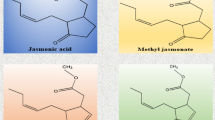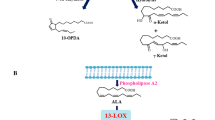Abstract
We have studied the movement and metabolism of oligogalacturonides through shoots of tomato (Lycopersicon esculentum L. cv Rutgers). Oligomers of polygalacturonic acid were prepared by enzyme digestion and gel filtration. These were end-reduced with [3H]NaBH4, using an improved reaction method, to yield oligoalditols. The radiolabelled oligomer of degree of polymerisation 6 was supplied to tomato shoots through their transpiration stream. Analysis of the distribution of radiolabel in the plant, and TLC of radiolabelled material recovered from the plant revealed the following: a) material recovered from the plant could be identified as an oligogalacturonide from its behaviour on TLC and susceptibility to digestion with polygalacturonase; b) end-reduced oligogalacturonides moved freely through the plant and were not complexed to high-molecularweight compounds and immobilised; c) during passage through the plant, modifications to the oligogalacturonide occurred, presumably as a consequence of metabolism in the apoplastic space. We found evidence of i) esterification of the molecule, and ii) shortening of the oligogalacturonide chain. The results show that in the assay for protease-inhibitor-inducing factor using cut shoots, oligogalacturonide elicitors can move into the leaves and act directly on the cells producing protease inhibitor.
Similar content being viewed by others
Abbreviations
- d.p.:
-
degree of polymerisation
- PIIF:
-
protease inhibitor inducing factor
- Rf :
-
ratio of distance moved by solute to that of solvent front
Referencess
Baydoun, E.A-H., Fry, S.C. (1985) The immobility of pectic substances in injured tomato leaves and its bearing on the identity of the wound hormone. Planta 165, 269–276
Bishop, P.D., Makus, D.J., Pearce, G., Ryan, C.A. (1981a) Proteinase inhibitor-inducing factor activity in tomato leaves resides in oligosaccharides enzymically released from cell walls. Proc. Natl. Acad. Sci. USA 78, 3536–3540
Bishop, P.D., Pearce, G., Bryant, J.E., Ryan, C.A. (1981b) Isolation and characterisation of the proteinase inhibitor-inducing factor from tomato leaves. J. Biol. Chem. 259, 13172–13177
Brown, H.C., Mead, E.J., Subba Rao, B.C. (1955) Study of solvents for sodium borohydride and the effect of solvent and the metal ion on borohydride reductions. J. Am. Chem. Soc. 77, 6209–6213
Doherty, H.M., Selvendran, R.R., Bowles, D.J. (1988) The wound response of tomato plants can be inhibited by aspirin and related hydroxy-benzoic acids. Physiol. Mol. Plant Pathol. 33, 377–384
Doherty, H.M. (1989) A study on the role of oligosaccharides in the wound response of tomato plants. Ph.D. thesis, University of Leeds
Ericson, M.C., Elbein, A.D. (1980) Biosynthesis of cell wall polysaccharides and glycoproteins. In: The biochemistry of plants, vol. 3, pp. 589–616, Preiss, J. ed. Academic Press, London NewYork
Farmer, E.E., Moloshok, T.D., Saxton, M.J., Ryan, C.A. (1991) Oligosaccharide signalling in plants. Specificity of oligouronideenhanced plasmamembrane protein phosphorylation. J. Biol. Chem. 266, 3140–3145
Green, T.R., Ryan, C.A. (1972) Wound induced proteinase inhibitor in plant leaves. A possible defense mechanism against insects. Science 175, 776–777
Holloway, P.J. (1989) The chemical constitution of plant cutins. In: The plant cuticle, pp. 45–85, Cutter, D.E., Alvin, K.L., Price, C.E., eds. Linnean Soc. Symp. Series No. 10, Academic Press, London
Jin, D.F., West, C.A. (1984) Characteristics of galacturonic acid oligomers as elicitors of casbene synthase activity in castor bean seedlings. Plant Physiol. 74, 989–992
McLean, C., Werner, D.A., Aminoff, D. (1973) Quantitative determination of reducing sugars, oligosaccharides, and glycoproteins with [3H]borohydride. Anal. Biochem. 55, 72–84
McNeil, M., Darvill, A.G., Fry, S.C., Albersheim, P. (1984) Structure and function of the primary cell walls of plants. Annu. Rev. Biochem. 53, 625–663
Nothnagel, E.A., McNeil, M., Albersheim, P., Dell, A. (1983) Host pathogen interactions XXII. A galacturonic acid oligosaccharide from plant cell walls elicits phytoalexins. Plant Physiol. 71, 916–926
Peanrce, G., Strydom, D., Johnson, S., Ryan, C.A. (1991) A polypeptide from tomato leaves induces wound-inducible proteinase inhibitor proteins. Science 253, 895–897
Prehm, P., Scheid, A. (1978) Sensitive methods for the analysis of carbohydrates by gas chromatography of 3H-labelled alditol acetates. J. Chromatogr. 166, 461–467
Pressey, R., Avants, J.K. (1977) Occurrence and properties of polygalacturonase in Avena (oats) and other plants (maize, kidney beans, peas). Plant Physiol. 60, 548–553
Redgwell, R.J., Selvendran, R.R. (1986) Structural features of cellwall polysaccharides of onion Allium cepa. Carbohydr. Res. 157, 183–199
Rayan, C.A. (1974) Assay and biochemical properties of the proteinase inhibitor-inducing factor, a wound hormone. Plant Physiol. 54, 328–332
Ryan, C.A. (1988) Oligosaccharides as recognition signals for the expression of defensive genes in plants. Biochemistry 27, 8879–8883
Ryan, C.A., Bishop, P., Pearce, G., Darvill, A.G., McNeil, M., Albersheim, P. (1981) A sycamore cell wall polysaccharide and a chemically related tomato leaf polysaccharide possess similar proteinase inhibitor inducing activities. Plant Physiol. 68, 616–618
Sandhu, J.S., Frazer, D.R., Kennedy, J.F. (1982) Simple procedures for the addition of a 3H label to cellulose oligo-and polysaccharides and for the esterification of the products with [14C]nicotinic acid. Carbohydr. Res. 103, 181–185
Spiro, R.G. (1966) Analysis of sugars found in glycoproteins. Methods Enzymol. 8, 7–9
Takeuchi, M., Takasaki, S., Inoue, N., Kobata, A. (1987) Sensitive method for carbohydrate composition analysis of glycoproteins by high performance liquid chromatography. J. Chromatogr. 400, 207–213
Walker-Simmons, M., Ryan, C.A. (1977) Wound-induced accumulation of trypsin inhibitor activities in plant leaves. Survey of several plant genera. Plant Physiol. 59, 437–439
Wildon, D.C., Doherty, H.M., Eagles, G., Bowles, D.J., Thain, J.F. (1989) Systemic responses arising from localized heat stimuli in tomato plants. Ann. Bot. 64, 691–695
Yakushin, S. (1962) Application of the kinetic isotope effect of tritium to the investigation of the mechanism of hydrogen substitution and transfer reactions. Russ. Chem. Rev. 31, 123–131
Author information
Authors and Affiliations
Rights and permissions
About this article
Cite this article
MacDougall, A.J., Rigby, N.M., Needs, P.W. et al. Movement and metabolism of oligogalacturonide elicitors in tomato shoots. Planta 188, 566–574 (1992). https://doi.org/10.1007/BF00197050
Accepted:
Issue Date:
DOI: https://doi.org/10.1007/BF00197050




